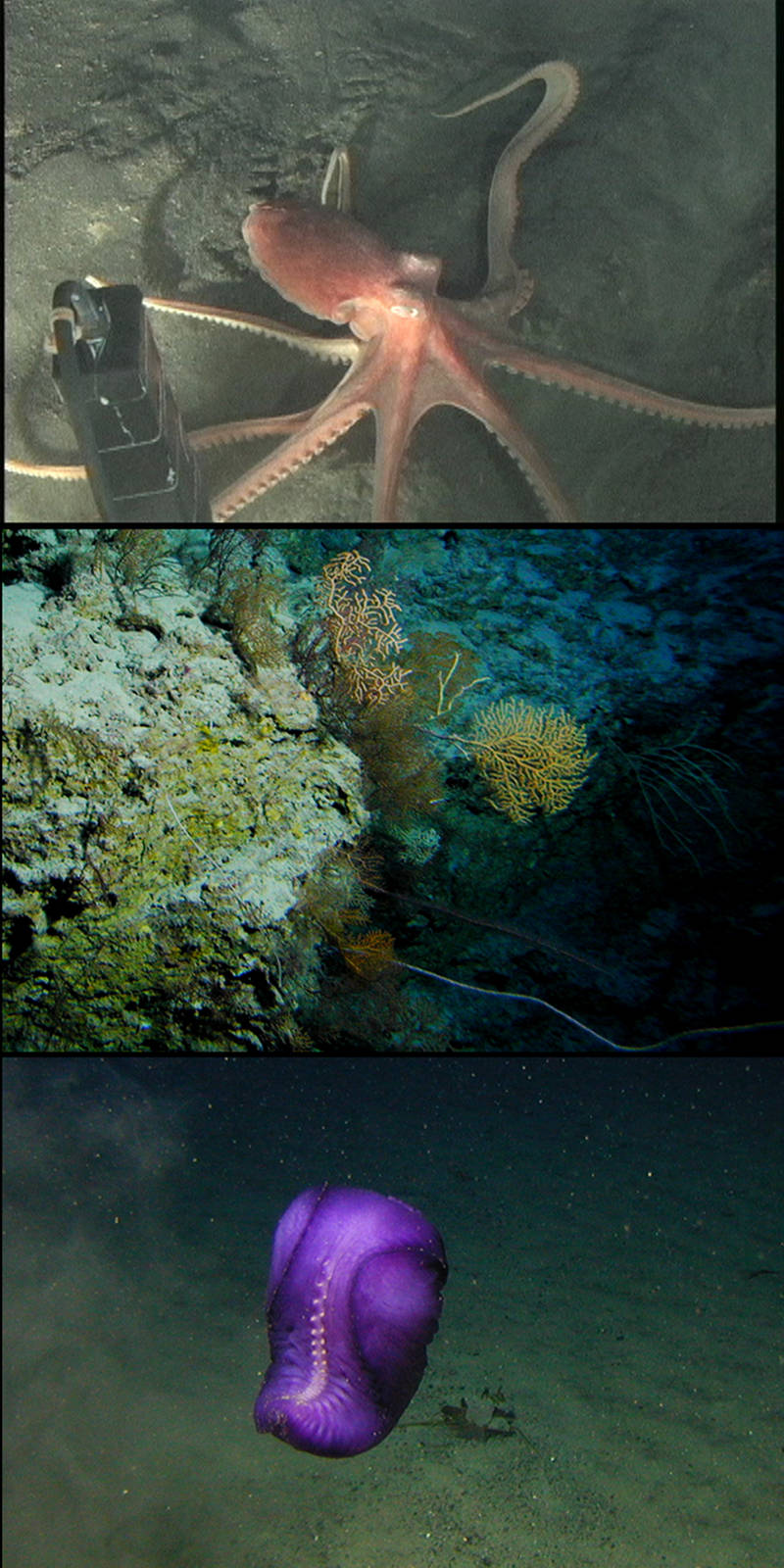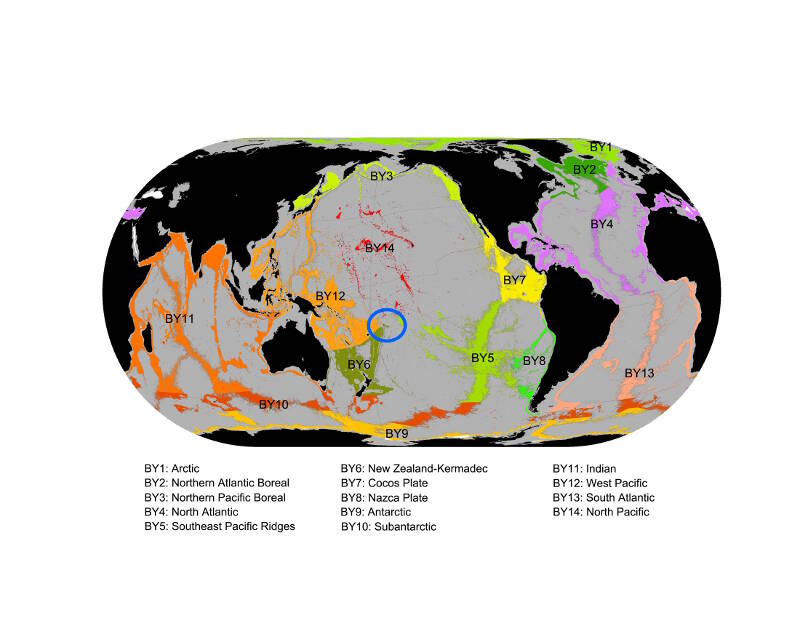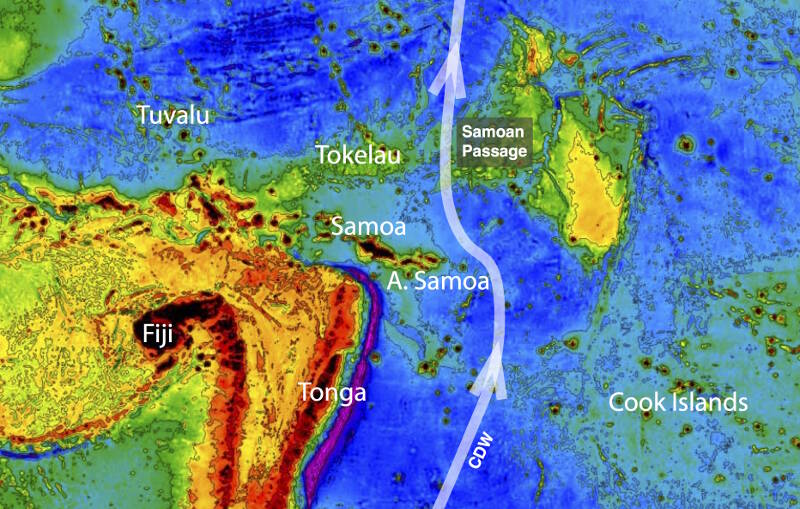
By
Santiago Herrera - Lehigh University
Les Watling - University of Hawaii at Manoa

Figure 1. Some of the fauna observed in American Samoa during dives with the Pisces V deep-diving manned submersible in 2005. Image courtesy of Christopher Kelley. Download larger version (jpg, 959 KB).
Our knowledge of the fauna inhabiting the deep waters of American Samoa is extremely scarce. According to the Ocean Biogeographic Information System (OBIS) database – currently the most comprehensive repository of marine biodiversity information – there have been just over 150 observations of animals from a handful of submersible dives, and only 38 scientific specimens have ever been collected in waters below 250 meters in American Samoa. Obtaining a baseline characterization of the species, communities, and ecosystems that occur in this area is of fundamental importance to understanding its place in the global biogeography puzzle of marine life.
In this expedition, we aim to fill a gap in our knowledge of the deep-sea biodiversity that exists in the central Pacific Ocean. We are particularly interested in exploring the seamount, hydrothermal vent, coral, and sponge garden habitats in American Samoa.
The lower bathyal area (between 800 and 3,500 meters, or approximately 2,600 to 11,500 feet deep) of American Samoa’s territorial waters is situated at the boundary of four biogeographical provinces (blue circle, Figure 2), as defined in the paper by Watling and collaborators published in the journal Progress in Oceanography in 2013. These provinces are: 1) the New Zealand – Kermadec province to the south; 2) the Southeast Pacific Ridges province, which includes the southern East Pacific Rise, to the east; 3) the West Pacific province, which includes areas off Fiji, Vanuatu, New Caledonia, northern Australia, the Coral Triangle, the Marianas, China, and Japan to the west; and 4) the North Pacific province, which includes areas off the Hawaiian Archipelago, Kingman Reef, Palmyra Atoll, Jarvis Island, the Phoenix Islands, Howland and Baker Islands, Johnston Atoll, and Kiribati, to the north.

Figure 2: American Samoa (encircled in blue) is located at the boundary of four lower bathyal biogeographical provinces (BY5, BY6, BY12 and BY14), as defined by Watling and collaborators in 2013. Modified Figure 19 from: Watling et al. (2013), A proposed biogeography of the deep ocean floor, Progress Oceanography 111: 91–112. Download larger version (jpg, 4.3 MB).
These provinces are mainly defined by differences in environmental parameters such as seawater temperature, food supply to depth, and surface ocean productivity, a product of photosynthesis. Therefore, it will be important to see and collect animals from American Samoa to compare with other areas, especially with the fauna of the Hawaiian archipelago, which is now quite well known.

Figure 3. Flow of the Circumpolar Deep Water (CDW) below 4,000 meters through the Samoan Passage. Modified Figure 19 from: Watling et al. (2013), A proposed biogeography of the deep ocean floor, Progress Oceanography 111: 91–112. Download larger version (jpg, 6.7 MB).
American Samoa is also an extremely important area for deepwater circulation. The region north of the islands is known as the Samoan Passage (Figure 3) and is considered the major gateway for the northward movement of deep (greater than 4,000 meters), cold and dense water into the north Pacific (Reid and Lonsdale, 1974). The fast currents moving through this passage may constitute a barrier, but also a mechanism for dispersal for certain deep-sea animal populations and species across the tropical central Pacific. Whether or not these currents are also a significant feature at shallower depths (above 4,000 meters) remains unknown (Voet et al., 2016).
Through collection of images and biological specimens using the remotely operated vehicle Deep Discoverer, we will be able to systematically characterize the deep-sea fauna and ecosystems that live in American Samoa. This information will allow us to establish similarities and biogeographic connections between American Samoa and characterized areas off New Zealand, Hawaii (CAPSTONE 2015, 2016), and Indonesia (INDEX 2010), in addition to other areas in the central Pacific that will be explored following this expedition.